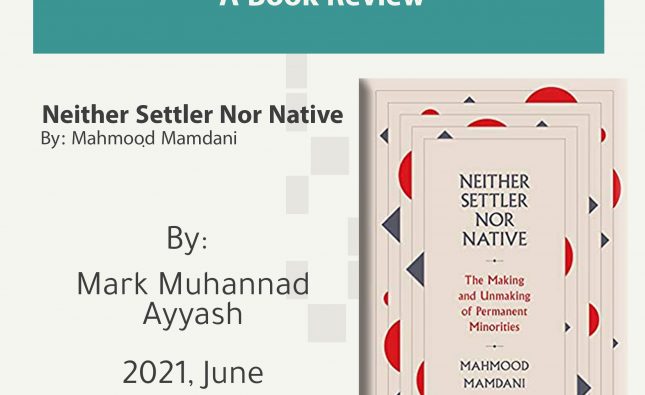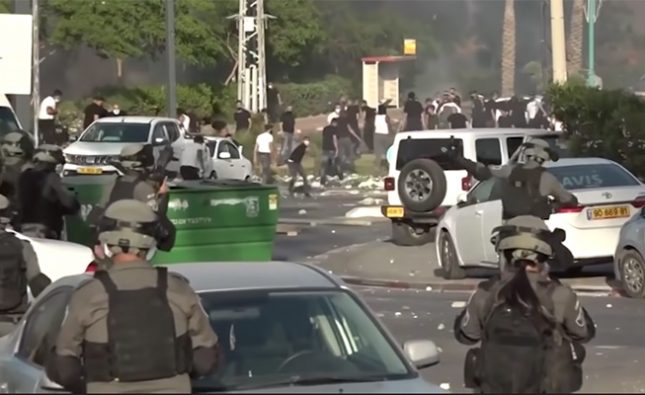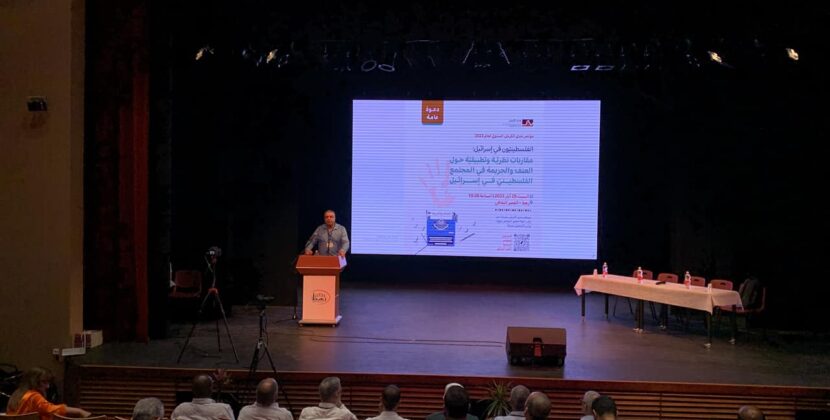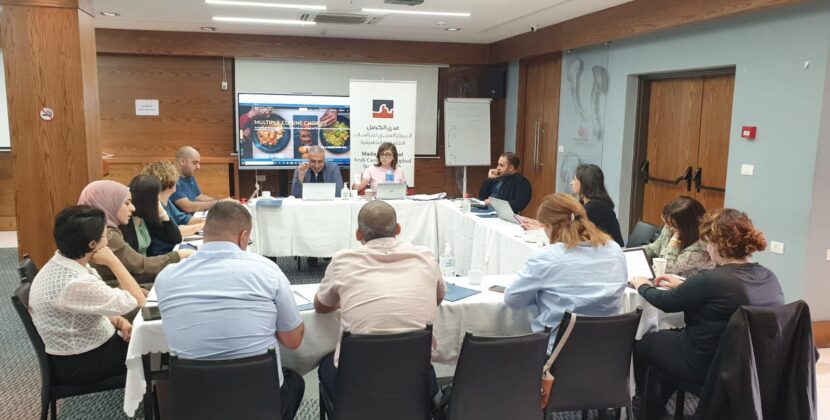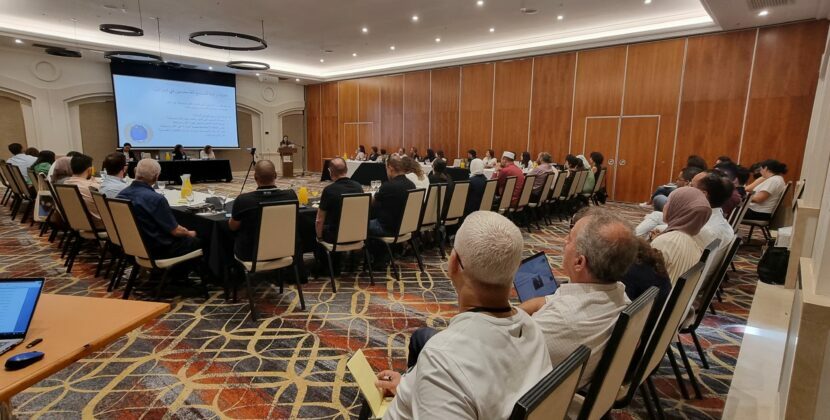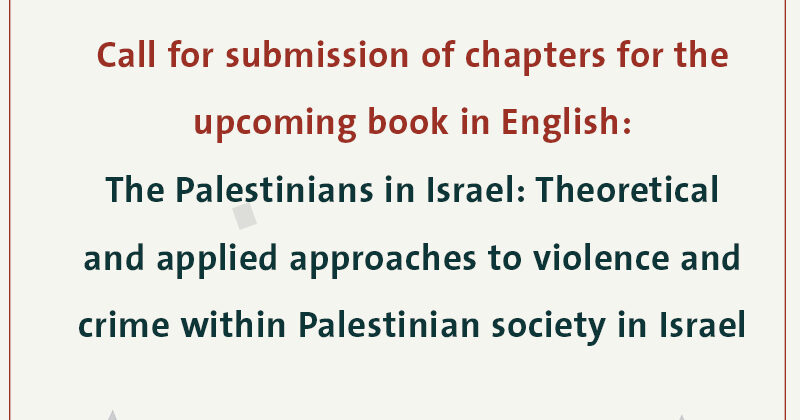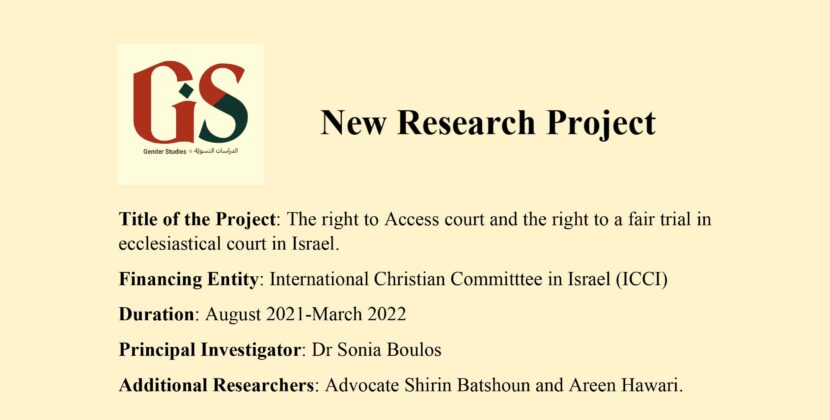Mada al-Carmel Center has released a new issue of Jadal Electronic magazine, edited by Muhannad Mustafa and Areen Hawari. This issue (29) deals with the public sphere and its context in the Palestinian community inside Israel from various aspects. The introduction starts by saying that the “public domain or public space is not a new subject for discussion in social literature; there have been writings on the study of the public sphere and its role in political culture and democracy, and its relationship with authority, whether political, social or religious. The public sphere aims to build the active citizen, through participation of the people in the formulation of public interest.”
The current issue of the Jadal magazine includes eight intellectual and cultural articles on the public sphere in the Palestinian community inside the Green Line from various angles and fields of knowledge.
 The issue starts with an article by Dr. Muhannad Mustafa in which he provides a theoretical approach to the public sphere and the theoretical discussion around it. The article refers to the debate among researchers on the difference between the official, public and private spheres, in that the last is the field of sound, while the first is the field of loyalty. By sound, he means the place where you hear the debates, discussions, different attitudes and opinions, and therefore it is diverse and controversial, while loyalty represents one voice, the voice of the authority. In contrast to the pluralism in the public sphere, there is a unilateralism in the official field, regardless of the political system. Democratic elections are resolved between the different political ideological positions in the midst of the struggle for authority, while the public sphere is not based on the settlement of the issue, but on the debates and discussions and the presence of all positions.
The issue starts with an article by Dr. Muhannad Mustafa in which he provides a theoretical approach to the public sphere and the theoretical discussion around it. The article refers to the debate among researchers on the difference between the official, public and private spheres, in that the last is the field of sound, while the first is the field of loyalty. By sound, he means the place where you hear the debates, discussions, different attitudes and opinions, and therefore it is diverse and controversial, while loyalty represents one voice, the voice of the authority. In contrast to the pluralism in the public sphere, there is a unilateralism in the official field, regardless of the political system. Democratic elections are resolved between the different political ideological positions in the midst of the struggle for authority, while the public sphere is not based on the settlement of the issue, but on the debates and discussions and the presence of all positions.
The second article entitled, “the public and private spheres”, is from Dr. Azmi Bishara’s book “Theses on a Deferred Awakening” published over a decade ago. It is, to  our knowledge, the first cultural text that establishes the discussion on the public sphere in the Palestinian community inside the Green Line, and has an in-depth analysis of the idea of the public and private spheres in Palestinian society. In this regard, Bishara says: “The public sphere is therefore not exactly a public place, nor is it always in the public domain, rather it is a socio-cultural state of mind able to visualize the common good, or to legally impose it in order to deter the exceptions that are incapable of visualizing, addressing or respecting it. For this to happen, a period of historical development is required in which a process of classification between the private and public sphere in the institutions and in consciousness has occurred.”
our knowledge, the first cultural text that establishes the discussion on the public sphere in the Palestinian community inside the Green Line, and has an in-depth analysis of the idea of the public and private spheres in Palestinian society. In this regard, Bishara says: “The public sphere is therefore not exactly a public place, nor is it always in the public domain, rather it is a socio-cultural state of mind able to visualize the common good, or to legally impose it in order to deter the exceptions that are incapable of visualizing, addressing or respecting it. For this to happen, a period of historical development is required in which a process of classification between the private and public sphere in the institutions and in consciousness has occurred.”
 In the third article, Dr. Ramiz Eid talks about the “Palestinian communal system”, which formed, until the mid-twentieth century, a shared public space that was managed by different groups in Palestinian society. In his presentation of the history of the communal system in Palestine, Eid emphasizes the social and economic role played by the latter in creating a management that relies on equality and local participatory democracy in decision-making. The article also emphasizes the role of the communal system in preventing external interference in the affairs of the local community and in its ability to prevent the sale of land. It opposes the first writings about it, particularly in the period of the British Mandate, which described it as an old economic system with a backward and inefficient structure in managing the economic and agricultural public sphere. Favoring the promotion of private ownership, which allowed for the sale of the land and control by the British Mandate and in line with what the Zionist forces and institutions demanded.
In the third article, Dr. Ramiz Eid talks about the “Palestinian communal system”, which formed, until the mid-twentieth century, a shared public space that was managed by different groups in Palestinian society. In his presentation of the history of the communal system in Palestine, Eid emphasizes the social and economic role played by the latter in creating a management that relies on equality and local participatory democracy in decision-making. The article also emphasizes the role of the communal system in preventing external interference in the affairs of the local community and in its ability to prevent the sale of land. It opposes the first writings about it, particularly in the period of the British Mandate, which described it as an old economic system with a backward and inefficient structure in managing the economic and agricultural public sphere. Favoring the promotion of private ownership, which allowed for the sale of the land and control by the British Mandate and in line with what the Zionist forces and institutions demanded.
In his article, Dr. Mussalam Mahameed discusses the social network “Facebook” describing it as confining the presence and highlighting masks, saying: “the cosmic  systems have become closer to the realization that leads to ignorance. The greater our exposure to obscured science, the more we realize how ignorant we are. We have experienced many types of communication, but we have not yet understood its philosophical dimensions. Even philosophers, it seems, are now scrambling to build a clear methodology for the definition of public space and its relationship to systems of communication. The theory of public space seeks to consolidate this concept and establish its foundations, but it frequently fails, in my opinion, as it chooses a philosophically loose cover that it wants it to wear in order to minimize the definition of communication.”
systems have become closer to the realization that leads to ignorance. The greater our exposure to obscured science, the more we realize how ignorant we are. We have experienced many types of communication, but we have not yet understood its philosophical dimensions. Even philosophers, it seems, are now scrambling to build a clear methodology for the definition of public space and its relationship to systems of communication. The theory of public space seeks to consolidate this concept and establish its foundations, but it frequently fails, in my opinion, as it chooses a philosophically loose cover that it wants it to wear in order to minimize the definition of communication.”
 Hama Abu Kishek starts her article, “The virtual space of the Palestinian minority inside Israel,” by talking about the Arab media inside the Green Line and the role of the censor/authority in its formation. She also addresses the image of Arabs in the dominant Israeli media, followed by the development of the Arab press with the spread of the Internet and its consumption, highlighting the emergence of the phenomenon of the youth movement across social networking among young Arabs inside the Green Line, a phenomenon that played a role in highlighting the opinion and participating in the debate, which has been used in some cases as a tool in mobilizing and organizing national protests and marches.
Hama Abu Kishek starts her article, “The virtual space of the Palestinian minority inside Israel,” by talking about the Arab media inside the Green Line and the role of the censor/authority in its formation. She also addresses the image of Arabs in the dominant Israeli media, followed by the development of the Arab press with the spread of the Internet and its consumption, highlighting the emergence of the phenomenon of the youth movement across social networking among young Arabs inside the Green Line, a phenomenon that played a role in highlighting the opinion and participating in the debate, which has been used in some cases as a tool in mobilizing and organizing national protests and marches.
In contrast, Deema Abu El Assal, in her article, “The illusion of the virtual world,” discusses the role of Facebook as a public network, wondering whether it is an equal  platform for everyone, or a virtual world that reflects reality and its conflicts. While in her article, Abu El-Assal presents different views of researchers of social networks on the latter’s ability to build a public space among its users and abolish discrimination and class and racist policies in some countries of the world. She is biased in favor of the claim that the ruling and powerful classes exploit Facebook and other networks, to keep up with the activities of users, their posts and content they share on their pages, to follow and monitor them. She argues that what young Palestinians face, based on their activity on Facebook, from political prosecutions, investigations and arrests, is an example of the fact that Facebook works on consolidating the existing power relations.
platform for everyone, or a virtual world that reflects reality and its conflicts. While in her article, Abu El-Assal presents different views of researchers of social networks on the latter’s ability to build a public space among its users and abolish discrimination and class and racist policies in some countries of the world. She is biased in favor of the claim that the ruling and powerful classes exploit Facebook and other networks, to keep up with the activities of users, their posts and content they share on their pages, to follow and monitor them. She argues that what young Palestinians face, based on their activity on Facebook, from political prosecutions, investigations and arrests, is an example of the fact that Facebook works on consolidating the existing power relations.
 Regarding defending the dignity of women and their bodies in the public and private space, Maysa Irshaid addresses in her article, the entry of women into the public sphere with their bodies. She analyzes the experience of a protest activity by a group of Palestinian women through dance in the public arena, in rebellion against the violence directed towards women. In addition, limiting the freedom of the woman, the human, and prosecuting her socially and morally based on her body, which was raised to maintain the boundaries set for it, pointing out that the entry gate to the public space is often restricted, limiting its entry (i.e. the body) to moving from one private space to another.
Regarding defending the dignity of women and their bodies in the public and private space, Maysa Irshaid addresses in her article, the entry of women into the public sphere with their bodies. She analyzes the experience of a protest activity by a group of Palestinian women through dance in the public arena, in rebellion against the violence directed towards women. In addition, limiting the freedom of the woman, the human, and prosecuting her socially and morally based on her body, which was raised to maintain the boundaries set for it, pointing out that the entry gate to the public space is often restricted, limiting its entry (i.e. the body) to moving from one private space to another.
Jadal Qassem concludes the issue with a theoretical essay on human dignity in the public sphere, in which she addresses the concept of human dignity and its  move from the private sphere to the public sphere. She argues that freedom represented in the human right to self-determination is a sole prerequisite to achieving human dignity, which remains an individual feeling until it moves from the private to the public through a revolution or a popular demand for change. This transition is accompanied by a demand for the right to participate in the development of laws and regulations, and choosing the shape of the political, social and economic system.
move from the private sphere to the public sphere. She argues that freedom represented in the human right to self-determination is a sole prerequisite to achieving human dignity, which remains an individual feeling until it moves from the private to the public through a revolution or a popular demand for change. This transition is accompanied by a demand for the right to participate in the development of laws and regulations, and choosing the shape of the political, social and economic system.
Available only in Arabic: https://old.mada-research.org/?p=8646*





